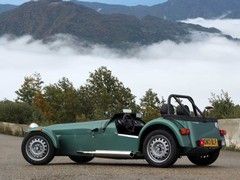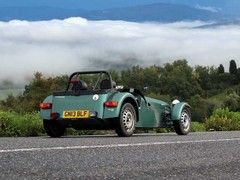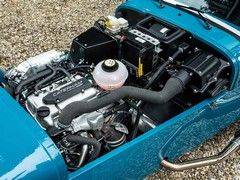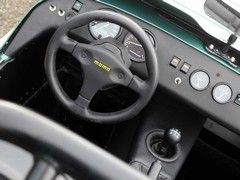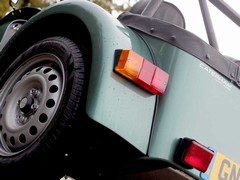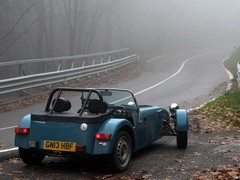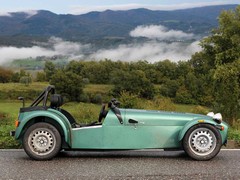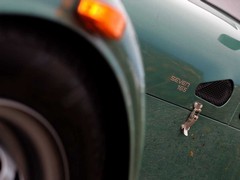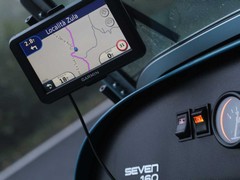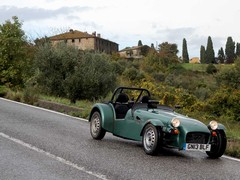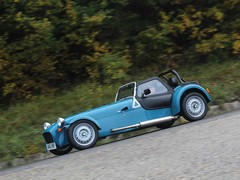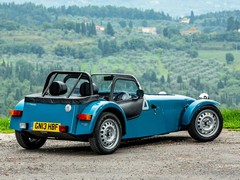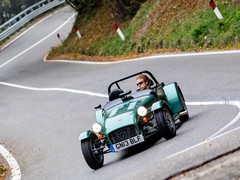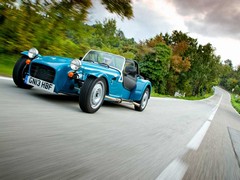Caterham Seven 160: Review
The back to basics Caterham Seven 160 versus an autumnal Raticosa Pass - PH holds on tight
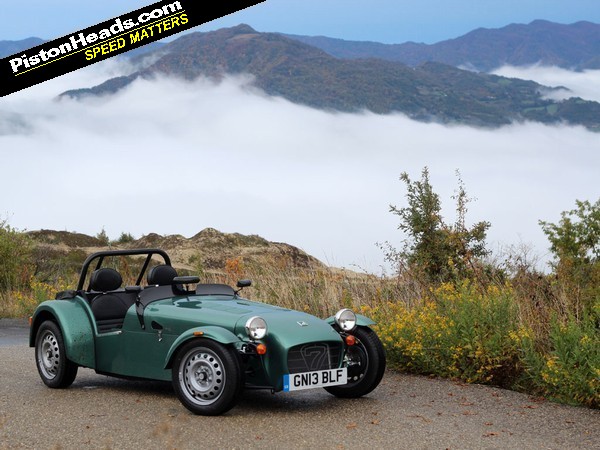
Downhill corners are scary given turn-in rests on two tiny contact patches and if you overburden them with braking and/or momentum they're easily overwhelmed. But once the front end is pointing roughly where you want it the options open up because even that meagre power output has no trouble at all overwhelming the skinny little Avons on their cute 14-inch steel rims.
Power comes in urgent little bursts, the turbo prompting enough coughs and sneezes from under the bonnet to consider a sachet of Lemsip for the tank. Slides come thick and fast, most deliberately provoked and easily caught but it's a busy old job in these conditions. Kind of like driving a Superlight, just in slow motion.
Innocent fun. Or, to follow the official line, 'accessible fun' given the £14,995 entry price. In what's been a busy year for new Seven variants word of a back to basics version first appeared in May. Headlines include that 80hp power output and corresponding 79lb ft of torque, narrower rear track, the gearbox and live rear axle from a Suzuki Jimny to replace the Marina one of old and a kerb weight of just 490kg. A factory built UK 160 will cost £17,995, undercutting the £19,995 kit price (£22,995 built) of the 125hp 1.6 Sigma-engined Roadsport by a significant margin.
Down to earth
And demonstrates how, despite the Alpine collaboration and lofty promises from owner Tony Fernandes of SUVs and more, Caterham's ambitions still rest firmly on the shoulders of a decades old Lotus cast-off. Whether it's on steelies or clothed in wind tunnel honed carbon bodywork like the AeroSeventhat stretches the format to the opposite extreme.
A curious mix of the archaic and modern, the 160 is a cost-conscious parts bin special in the best Seven tradition, held together with some pukka engineering in the calibration of its Suzuki 660cc turbocharged engine by Caterham Technology and Innovation (CTI) to meet export-friendlyemissions targets in Europe and Japan, where the 165 counts as a Kei car. Tokyo hipsters are going to love it.
Bigger picture, it's exactly a year to the day since we drove the experimental Ecoboost engined Seven, proof that even the humble Caterham can't escape the pressures for downsizing, turbos and fuel efficiency. That car had nearly double the power of this one and despite the existing relationship with Ford as an engine supplier Caterham has sought a new partnership with Suzuki, the fact a crate Ecoboost engine costs nearly three times as much as a Sigma demonstrating why this route was chosen.
Forcing our hand
The Ecoboost car was an interesting novelty but, really, do we want our Sevens turbocharged? The 620R uses a supercharger, paired a 2.0-litre Duratec and delivering a searing mix of normally aspirated surge and forced induction punch. Most of all it's linear in its power delivery. There's a lot of it but that Seven adjustability and predictability are there, just at much, much higher speeds.
With just 660cc the turbo is doing proportionally much more of the legwork here, the fear being that lag and sudden swells of boost might upset the delicate balance of the Seven's handling.
The first car we drive is a 165, complete with the aero screen European homologation rules require. For some ludicrous reason the standard screen doesn't comply with field of vision regs, the mirror on top of the dash of the 165 doing a far more effective job of blocking your view. With just 300 miles on the clock the engine feels tight and thrashy revving beyond 5,000rpm, though it will in fact buzz its way round to 7,000. Most of the action is between 4,000-5,500rpm though, this high-rev harshness and narrow band of action meaning finding a sweet spot for corners is a challenge.
Leave it in a higher gear and it bogs down, shift down to early and it thrashes uncomfortably. With 1,600 miles on the clock the UK spec 160 feels a lot more at ease with itself, the power band wider and more exploitable. It still feels wrong entering a corner in fourth with less stabilising engine braking but the engine will pull strongly enough on the way out, meaning you adopt either a more relaxed gait or frantic thrashy one according to mood.
If the general vibe and surroundings are classic Seven the hissing, cooing and chuffing from under the bonnet most definitely isn't. We'll wait until we've tried one with a few thousand miles on the clock before making a definitive judgement but it's harder to find a flow with the turbocharged engine than it is with the Sigma or Duratec cars. It's less a question of power - 163hp per tonne (minus driver, adjust according to how powerfully built you are) is the same ballpark as an MX-5 or GT86 - and more about how it's delivered.
Chuffing brilliant
In the normally aspirated cars you're happy snapping the stumpy gearlever this way and that and the car never seems to complain. Here you have to second-guess where you're going to end up in the rev range, less because of any lag but more because it just doesn't seem to like those downshifts into corners that buzz up into the higher reaches. The second to third shift demands a firm hand too.
Where it does impress is in its delicacy and poise though, those ultra skinny tyres offering a completely different feel to anything else on the road. If you've ever driven a Smart Roadster - especially one of the basic ones on steel wheels - the noise and vibe will feel familiar, the ability to shift gears yourself in the Seven most welcome though.
There's a delightfully old-school sense of wriggle and squirm through the Seven's wheel and chassis, albeit tied down with more sophistication than the basic design would suggest. You might sit atop that live axle but it doesn't bounce or shuffle as you might expect and the undiluted messages between pedals, tyres and steering are all pure Seven and totally uncorrupted.
It can't quite exhilarate like its bigger-engined brothers but a 25 per cent cost saving suddenly makes it much more affordable. And, truth be told, the whole package lives up to the Seven's minimalist mantra much more convincingly than its carbon-bodied concept brother.
CATERHAM SEVEN 160/165
Engine: 660cc 3-cyl turbocharged
Transmission: 5-speed manual, rear-wheel drive
Power (hp): 80@7,000rpm
Torque (lb ft): 79@3,400rpm
0-62mph: 6.5sec
Top speed: 100mph
Weight: 490kg
MPG: TBC
CO2: TBC
Price: £14,995 inc. VAT kit, £17,995 inc. VAT built
A little taster clip of the Caterham and the conditions (apologies for the wind noise - authentic at least):
Gassing Station | General Gassing | Top of Page | What's New | My Stuff



